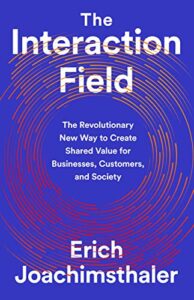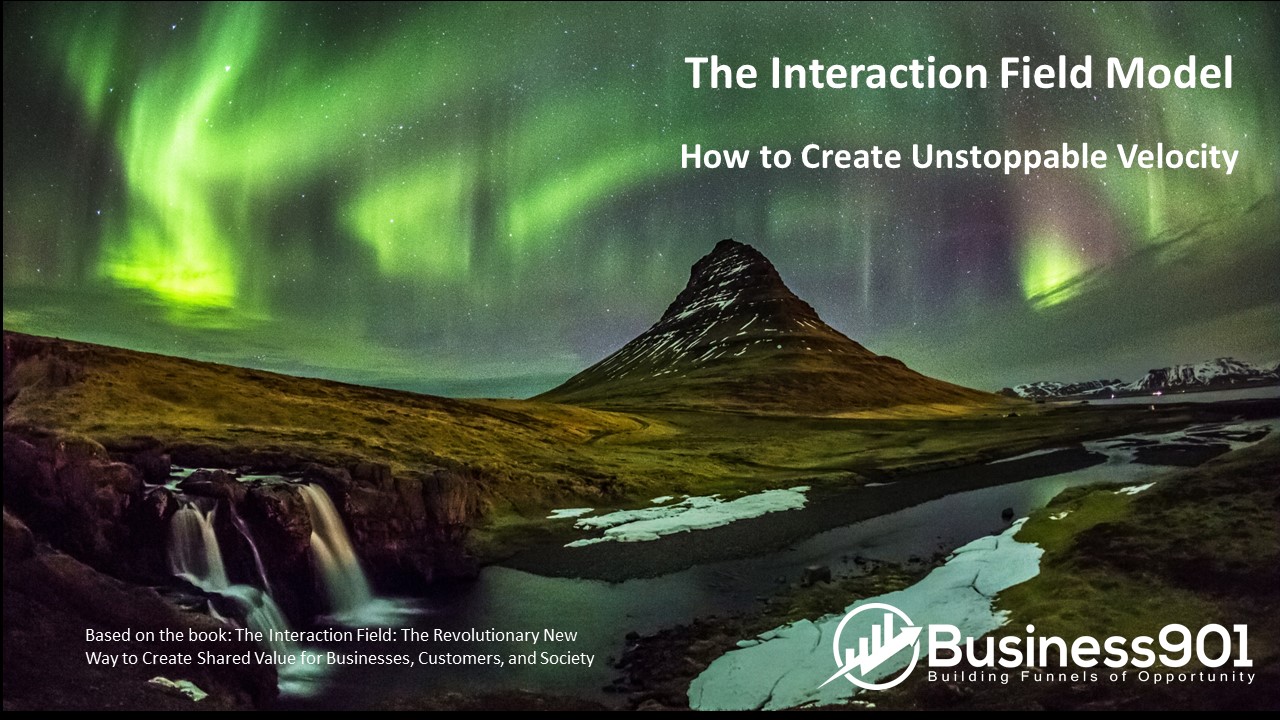The Interaction Field: The Revolutionary New Way to Create Shared Value for Businesses, Customers, and Society, Public Affairs (September 15, 2020) by Erich Joachimsthaler was a book I read several years ago and just recently opened back up for review. Instead of re-reading the material, I took a stab at writing an outlined based on the table of contents and my present knowledge of the subject. This work is not necessarily an interpretation of the authors views or a direct recap of the book. I encourage you to read the authors work for a complete understanding of the field. (Amazon Affiliate Link: https://amzn.to/3eGWsma).
years ago and just recently opened back up for review. Instead of re-reading the material, I took a stab at writing an outlined based on the table of contents and my present knowledge of the subject. This work is not necessarily an interpretation of the authors views or a direct recap of the book. I encourage you to read the authors work for a complete understanding of the field. (Amazon Affiliate Link: https://amzn.to/3eGWsma).
The Interaction Field Model—How to Create Unstoppable Velocity: The interaction field model is a tool that can be used to create unstoppable velocity. It is based on the principle of interacting fields, which states that when two or more fields interact, they make a new field that is the sum of the original fields. This new field can then be used to create additional fields. The interaction field model can be used to create any desired outcome, including unshakable confidence, by aligning the fields of intention and attention. When these two fields are aligned, the resulting energy field will be much greater than the sum of the two original fields, creating unstoppable velocity.
Revolutionizing a Company and industry: Interactions Versus Transactions: To revolutionize a company or industry, it is necessary to focus on interactions rather than transactions. This means creating a culture of engagement and collaboration, where employees feel like they are part of something larger than themselves and are motivated to work together to achieve common goals. It also means establishing relationships with customers and other stakeholders based on trust and mutual respect, rather than simply exchanging goods or services for money. By focusing on interactions, companies and industries can create an environment of innovation and growth where everyone involved feels like they are part of something special.
New Consumers: How to Reach Them Given Rising Expectations: Companies are finding new ways to reach consumers as the world becomes more connected. With the rise of social media and the growth of online shopping, companies can easily target specific audiences. However, as expectations rise, so does the competition. To stand out, companies need to offer something unique that speaks to the needs and wants of their target audience. Whether it’s a personalized experience or exclusive access to products and services, companies need to find ways to differentiate themselves to attract and retain new consumers.
Framing and Branding: The Sociology of Gravitational Pull: When we talk about “framing” in the context of marketing and branding, we’re referring to the idea of creating a particular perception of a product or company in the minds of consumers. This can be done in several ways but often includes using specific language, images, and symbols to create an emotional connection with potential customers.
The notion of “branding” is closely related to framing and refers to creating a unique identity for a product or company that sets it apart from its competitors. This can be done by creating a recognizable logo, using distinctive colors or fonts, and developing a tagline or slogan. Both framing and branding are important tools for companies looking to market their products or services successfully. By carefully crafting how their products are presented to consumers, they can create an irresistible gravitational pull that helps them stand out from the rest.
Innovation: How a Traditional Company Can Act Like a Start-Up: For a traditional company to act like a start-up, it must be willing to take risks, embrace new ideas, and be open to change. It must also have a culture that supports and encourages innovation. This means creating an environment where employees feel comfortable sharing their ideas, experimenting, and failing. Many traditional companies have successfully innovated by creating dedicated innovation teams or labs. These teams are given the resources and freedom to experiment with new ideas and technologies. They are also often given a mandate to failure, which means they are not penalized for trying something new that doesn’t work out.
If your company is not currently structured in a way that supports innovation, there are some things you can do to change that. Encourage employees to share their ideas, provide resources for experimentation, and create an environment where failure is not only tolerated but celebrated.
Solving Difficult Challenges: Reshaping a Complex industry: There are ways to solve these complex challenges. One way is to keep up-to-date on the latest industry news. This will help you understand what is happening in the industry and what changes are being made. Another way is to network with other professionals in the industry. This will give you a better understanding of the industry’s inner workings and how to navigate it best. Finally, it is always important to be learning. Most industries are constantly changing, and staying ahead of the curve is important. By continually learning and keeping up with the latest trends, you will be able to solve any difficult challenges that come your way.
The Virtuous Cycle: The Sociology of Gravitational Pull: The virtuous cycle is the name given to the idea that our social interactions tend to reinforce our existing beliefs and values. This can be seen as a positive feedback loop, where our actions tend to support and maintain the status quo. This cycle can be broken down into four main stages: confirmation bias, self-fulfilling prophecies, groupthink, and herd behavior. Confirmation bias is the tendency to seek information that supports our existing beliefs and interpret new information to confirm those beliefs. This can lead us to only pay attention to evidence that supports our point of view and to discount or ignore evidence that contradicts it. Self-fulfilling prophecies are confirmation biases in which we believe something will happen because we expect it to happen. For example, if we believe that people from a certain group are untrustworthy, we may act in ways that make them seem untrustworthy, even if they were not originally.
Groupthink is people’s tendency to conform to their social group’s norms and values, even if those norms are harmful or counterproductive. This can lead to bad decisions being made, as people are more concerned with fitting in than with
Superfluid Markets: Eliminating Frictions: Superfluid markets are those that can eliminate frictions and move smoothly. For a market to be superfluid, it must have low transaction costs, high levels of liquidity, and efficient price discovery. When these conditions are met, market participants can trade quickly and easily without worrying about obstacles getting in the way. This results in a more efficient allocation of resources and greater overall economic growth.
Delivering Customer Experiences: The Role of Brand in Business Strategy: Delivering customer experiences is a critical part of any business strategy. Brand plays a significant role in this, as it can influence how customers perceive and interact with a company. Strong branding can help create loyalty and trust while differentiating a company from its competitors. Considering how a brand can be leveraged to deliver the best possible customer experience is essential.
Velocity Versus Clicks—On Becoming an Interaction Field Company: It’s been argued that the future of business lies in becoming an “interaction field company.” What does this mean? In short, it means shifting your focus from clicks to velocity. Interaction field companies are built on the premise that interactions—not clicks—are what matter. They’re designed to create more opportunities for engagement and connection, not just more ways to collect data. This shift requires a different mindset, one that values quality over quantity. It’s about creating meaningful and valuable experiences, not just frictionless and fast.
References:
The – Vivaldi. https://vivaldigroup.com/en/wp-ontent/uploads/sites/2/2021/10/Interaction-Field_Chapter-One.pdf
Herd Mentality – Definition, History, and Examples | Marketing91. https://www.marketing91.com/herd-mentality/
The property clock: how do property cycles work? | Finder. https://www.finder.com.au/what-is-the-property-clock-and-how-does-it-work
Evolving Upskilling And Reskilling Needs: Three Tips For – Forbes. https://www.forbes.com/sites/forbescoachescouncil/2022/07/27/evolving-upskilling-and-reskilling-needs-three-tips-for-staying-ahead-of-the-curve/
Why Business is Personal: It’s All About Connection. https://www.linkedin.com/pulse/why-business-personal-its-all-connection-lakitia-m-woodard-mba

